
Are you looking for a way to keep your pool cover from sagging this winter? You’re not alone! We know firsthand that sagging and sunken covers can be quite a nuisance.
But we’ve got a few tricks up our sleeve to get you through the colder months with a strong, sturdy cover. In this blog post, we will share with you our tried-and-true tips for preventing sagging—so bring on those cool temperatures because your pool will be prepared!
Let’s dive right in:
Pool covers are a great way to protect swimming pools from dirt, debris, and animals. However, too much of a good thing can be bad – pool cover sagging is the unfortunate result of too much water and debris resting on its surface for too long.
The root causes for this effect are primarily:

Rainwater drainage is a critical factor in keeping a pool cover looking taut, wrinkle-free, and undamaged. Without enough drainage, the cover can sag and cause pool owners to endure more time – and more expense – maintaining it.
Poor drainage can lead to damage due to standing water on top of the pool cover which may eventually weigh it down over time. This results in long-term wear and tear as well as costly repairs or replacements.
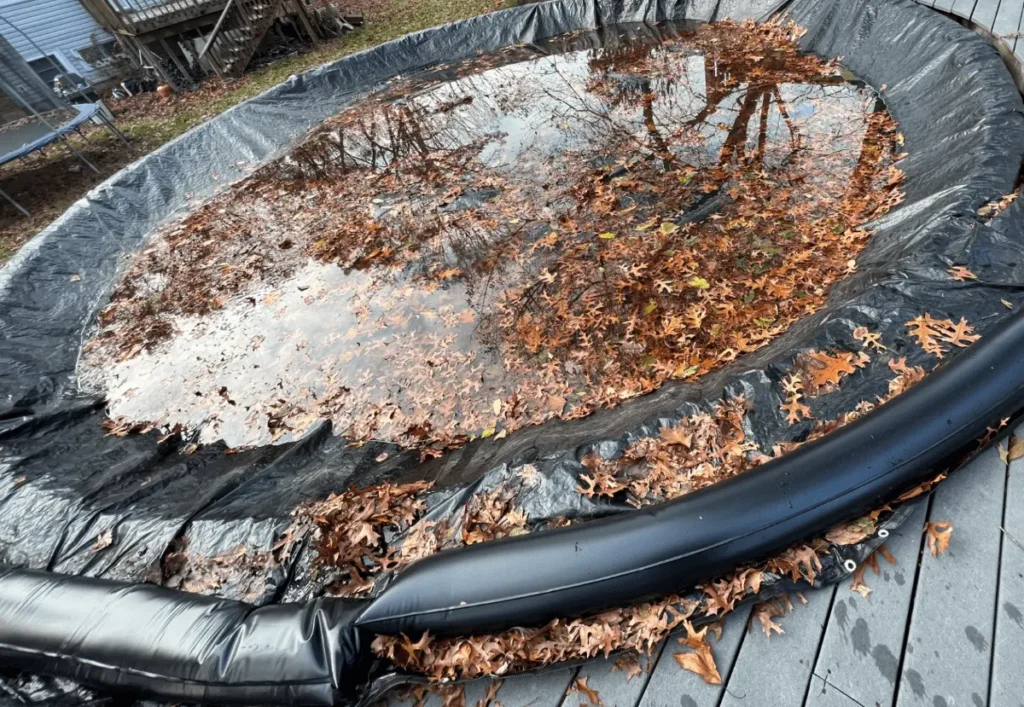
Collected leaves and debris on a pool cover act as a sponge by absorbing water, which then increases the weight of the cover.
With the continuous addition of extra weight, the cover begins to sag – especially around weak spots – leading them to tear or break altogether.
Additionally, the increased pressure on the seams accelerates wear and tear. This, in turn, leads to tears or gaps in which even more debris and rainwater can gather – resulting in a cycle of destruction ending with you having to replace your cover.
So remember: don’t overlook leafy visitors when it comes to looking after your pool cover!
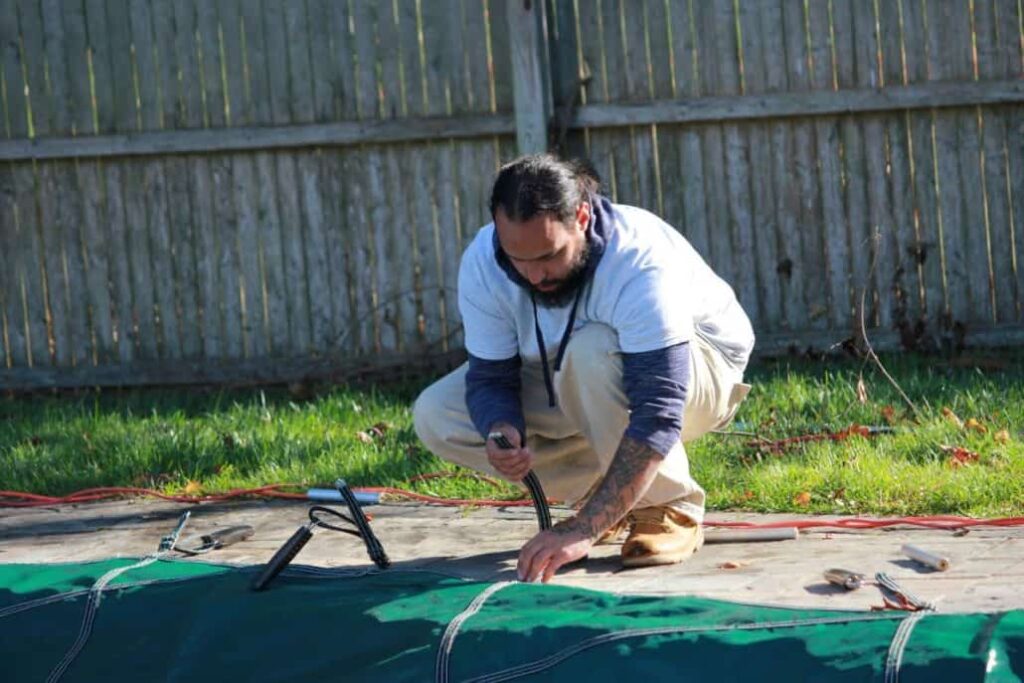
During the winter months, it might be tempting to put your pool safety cover straps on the back burner―but not adjusting those straps could have consequences!
Keeping the pool cover properly fitted with adjusted straps helps keep your pool safe throughout the off-season.
Not only that, but special care around wintertime is important because temperatures are lower and the materials used in many of these covers are affected by changes in temperature.
If you don’t do a periodic check of your cover straps to make sure the cover is secured properly to the pool, problems can arise such as sagging and water pooling.
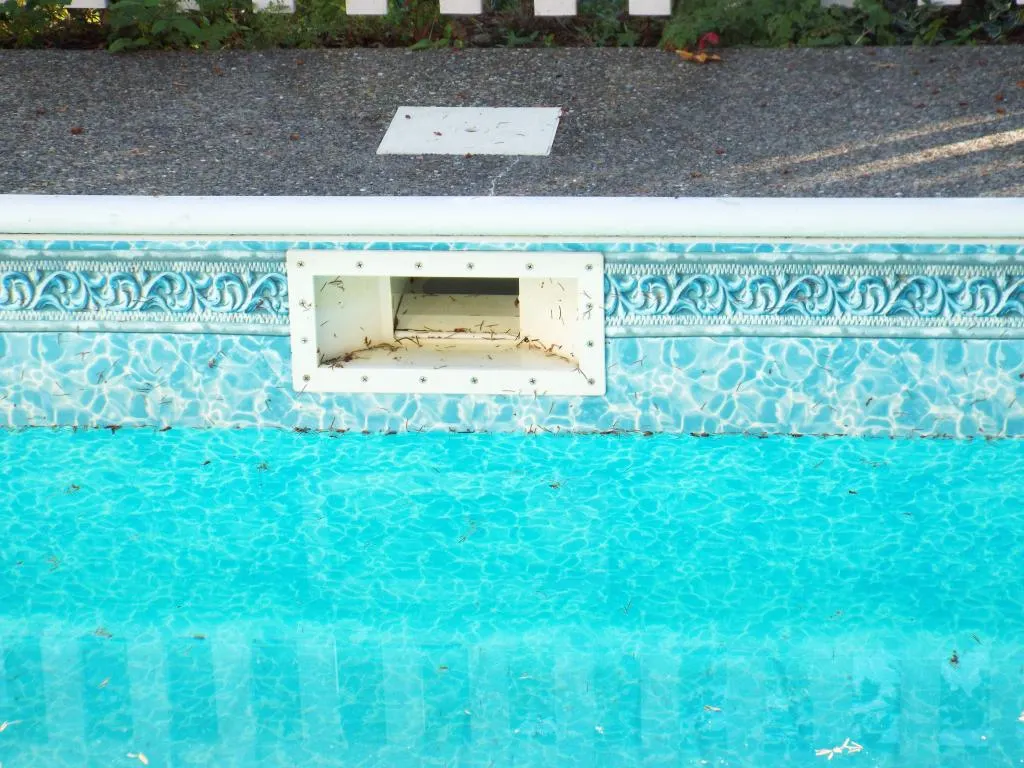
If your pool is not kept at the right water level, this can also cause your cover to sag. Ideally, you should keep an eye on your water levels throughout winter months and adjust accordingly.
The general rule of thumb for proper winter pool maintenance is to make sure the water level is slightly lower than the bottom of the skimmer…about an inch or two lower should be ideal.
If you have a gunite pool with tiles, however, be sure to keep your water level about 2 inches below your tile line – otherwise, your tiles will freeze and crack!
If you let your water level drop too low, your cover will sag and become very heavy (the water in the pool that’s underneath the cover helps keep the cover afloat and taught).
This is also why safety cover companies will void your warranty if the water level is too low (they know it damages the cover).
On the flip side – if you let your water level raise too high (from lots of rain/snow), you could risk the pool overflowing and flooding your yard!
While water accumulation is a fact of life when it comes to your pool cover, that doesn’t mean you have to feel powerless in the face of such puddles!
The truth of the matter is that there are several effective and easy techniques to help you remove water from your cover.
The first solution is an easy one – pump the water off with a cover pump!
There are two different types of cover pumps you can get – an automatic pump, or a manual pump.
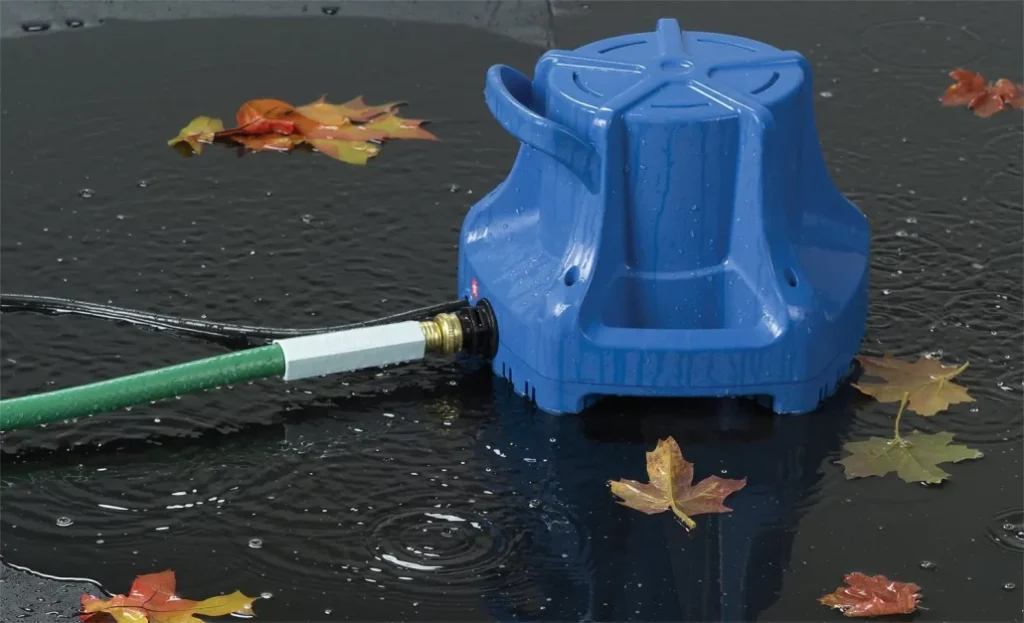
An automatic cover pump is the best solution for removing standing water from your cover with minimal effort. This type of pump will turn on and off when it senses water, so it’s a great solution that saves lots of time.
Here’s a link to our favorite automatic cover pump on Amazon: Little Giant Automatic Swimming Pool Cover Pump (affiliate link)
Step 1: Begin by finding a flat and level area to place your automatic cover pump. Make sure it is away from any pool edges or ladders, so it won’t be disturbed.
Step 2: Place the pump in the center of this area and connect the supplied hoses and power cord. Make sure there are no kinks or twists in the hose that might cause the pump to malfunction.
Step 3: Turn on the power switch located outside of the pump – this will activate it automatically when water is detected.
Step 4: Once activated, the motor will begin to draw water out of your pool cover and deposit it into a nearby drainage area. The suction force created by the motor should be enough to remove both large and small amounts of standing water quickly and efficiently.
Step 5: Sit back and relax! The beauty of an automatic cover pump is that it will turn on when needed, and turn itself off when the water is gone…truly, a set it and forget it approach.
An automatic pool cover pump certainly has a lot of positives to its name – it can save you time and keep your cover from filling with water when you’re away from home. However, there is one major downside; these pumps are not cheap.
While the high prices may seem worth it for the luxury of having an automated system, for some pool owners it simply isn’t feasible.
If you’re looking for an alternative that is more price-friendly, try a manual version instead! Though it will take more effort on your part to operate correctly, the drops in cost could offset the extra sweat.
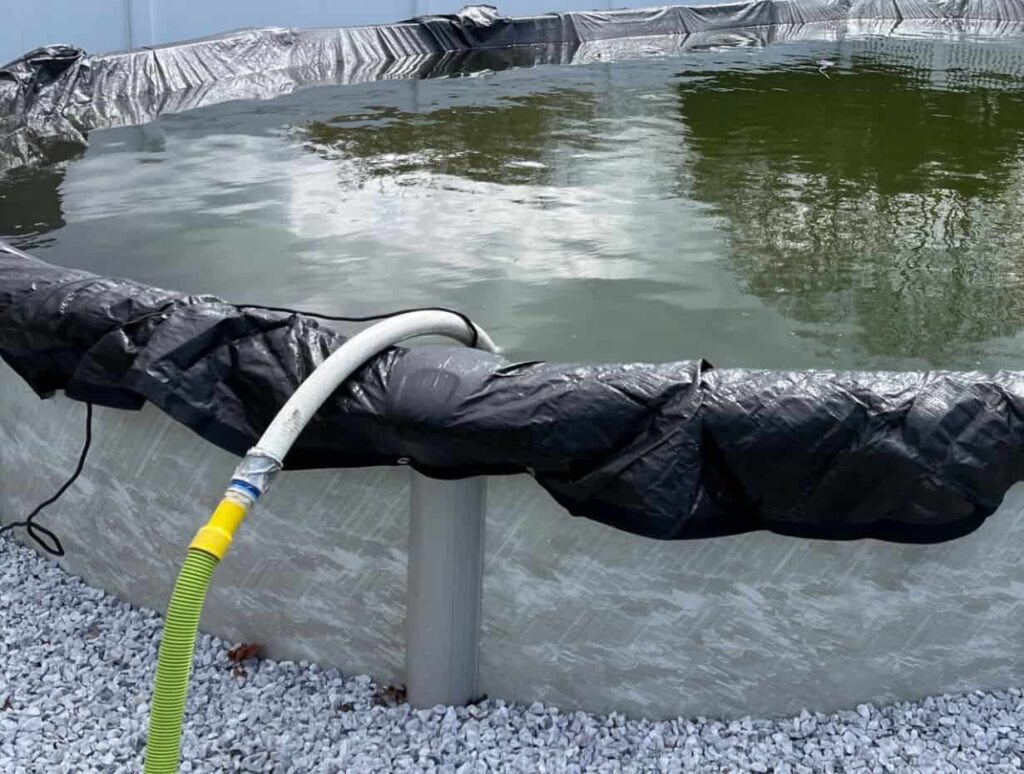
A manual pool cover pump is an essential tool for pool owners when it comes to keeping the water surface free from debris. Like automatic pumps, it works by drawing out the excess rainwater that collects on the pool cover.
Its lightweight design makes it easy to move around, while also being incredibly durable and able to withstand even rough weather conditions.
With its reliable performance, a manual pool cover pump is one of the best options on the market when it comes to keeping your pool clean. Best of all, its low cost means you don’t need to break the bank just to maintain your precious oasis!
A third option is to get the water off the pool cover without using a pump at all! Indeed, all you need is a garden hose and some patience. Here’s how you do it:
Overall, manual pool cover pumps are a great choice when it comes to keeping your pool covered during winter months or while away on vacation. Just be sure that you use all safety measures and follow instructions closely for optimal performance!
A third option is to get the water off the pool cover without using a pump at all! Indeed, all you need is a garden hose and some patience. Here’s how you do it:
This is a great and cost-effective way to get your water off the pool cover. Be warned, however, that it can be quite labor intensive – and it’s not always fun with the chance of getting wet when it’s cold out!
Once you’ve gotten all of the water off, it’s time to keep it from coming back.
Preventative maintenance and routine cleaning are key when it comes to keeping pool covers free of excess water – but there are also some special tools and techniques that can make the job even easier!
The best way to keep water from accumulating on your pool cover is by regularly removing debris from its surface. Whether you take time each week or month (or hire us) focus on clearing the cover of leaves, twigs, and other debris that can accumulate from the wind.
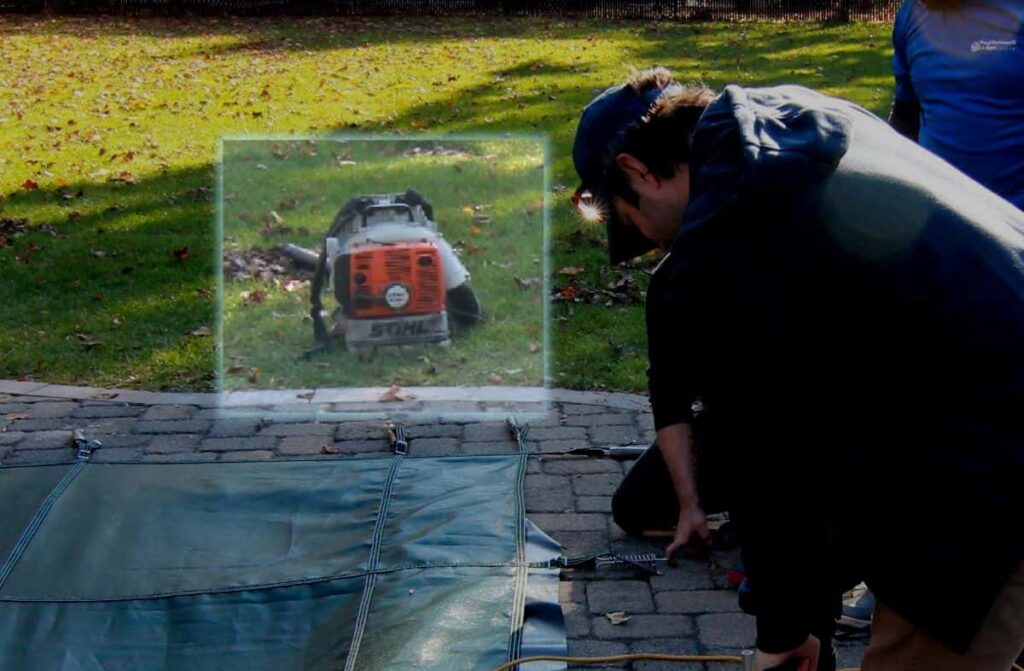
One way to do this is to use a leaf blower. Using a leaf blower to help clear debris from a pool cover is a surprisingly useful tip…and while it may seem like an odd way to do the job, it’s super effective!
A leaf blower can be an extremely helpful tool, cutting down the time you spend manually brushing off the inevitable build-up of pool cover contaminants.
That being said, if you opt to use a leaf blower, make sure to check the power settings and adhere closely to the manufacturer’s recommended speed/power so that you don’t damage the cover.
Also, be sure to stand 5 to 10 feet back from the edge of the cover when using the blower – falling in the pool certainly won’t help speed up the process!
Next, if you have a cover pump, be sure to use it regularly throughout the year as needed – particularly after bad weather! This will help prevent sagging and ensure your pool stays in prime condition all year round.
Be sure to reach out to us if you need a cover pump. They’re well worth the expense as they are the best preventative measure for ensuring your cover stays undamaged throughout the off-season.
There are a few ways that you can keep your pool cover from sagging and ensure it stays in pristine condition throughout the off-season. Automatic and manual pumps, garden hoses, and leaf blowers are all great tools to have on hand when tackling this task – just be sure to stay safe!
Routine maintenance – such as regularly removing debris from the cover – is also essential to avoid water accumulation and any potential damage down the line.
If you need a cover pump or replacement cover, or if you’re interested in our new winter watch service, contact Romanelli & Son Pool Service today!
We’re always happy to help. Give us a text/call at 631-496-1685.
Good luck!

We make pool ownership easy with stress-free maintenance, expert repairs, and cutting-edge tech. From sparkling water to pool automation, we handle every detail so you can relax and enjoy your pool.
© 2025 Paul Romanelli & Son Pool Service.